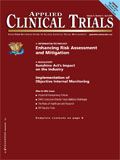ERT and UCLA Partner for Postmarket Study on Chronic Obstructive Pulmonary Disorder
Applied Clinical Trials
ERT and UCLA partner in postmarket studies with an eye toward telehealth.
Last month, ERT initiated along with its academic partner UCLA, its first foray into postmarket studies with an eye on the future of telehealth.
The year-long study of 200 patients suffering from chronic obstructive pulmonary disorder (COPD), will gather evidence in a controlled trial—called the CLEAR study—that will support the use of ERT's respiratory devices for remote health monitoring that would benefit COPD patients by allowing for early interventions.
Michael Taylor, Senior Director, Healthcare Solutions for ERT, told Applied Clinical Trials that this observational trial has been on ERT's radar since it acquired the respiratory diagnostic device manufacturing and services provider from CareFusion in June 2010.
The goal was to take these respiratory devices, primarily used for monitoring participants in clinical trials, into the larger arena of remote health or telehealth.
To that end, ERT partnered with Christopher Cooper, MD, Professor of Medicine and Physiology at the David Geffen School of Medicine at UCLA; Medical Director, Chronic Obstructive Pulmonary Disease Program; Medical Director, Clinical Exercise Physiology Laboratory; Director, Exercise Physiology Research Laboratory as the study's principal investigator.
Cooper is widely recognized as a proponent of using devices in the home to keep COPD patients out of the hospital by early detection of exacerbations. Having conducted a study in the mid-2000s on a much smaller population, Cooper felt this study with ERT's funding could take his hypothesis to the next level.
COPD
According to the National Heart, Lung, Blood Institute of the NIH, COPD is the third leading cause of death in the United States. This respiratory disease is also known as emphysema or chronic bronchitis; strikes people over the age of 40 and afflicts smokers more than non-smokers, although environmental and genetic factors play a part.
Spirometry is a breathing test that, amongst other parameters, shows how fast people can blow air out of their lungs. Since there is no cure for COPD, active monitoring of lung function and medication management are used to manage the symptoms.
Research
The CLEAR study will operate as a randomized trial, enrolling patients over 40 years old in the Los Angeles community. The study brings together home based spirometry, activity monitoring, adherence scoring, and self-reported symptom monitoring, all enabled through ERT's technology.
On a daily basis from the patient's home, enrollees will track their lung function using ERT's SpiroPro device, which also records symptoms using the CLEAR Sx Assessment questionnaire.
The CLEAR Sx assessment tracks symptoms, such as breathlessness and cough on the SpiroPro, using a series of screens adapted from previously reported studies for the detection of COPD exacerbations.
The SpiroPro device will also deliver the CLEAR Rx and CLEAR Ex Assessment questionnaires, developed by Cooper and ERT to determine prescription adherence and perceived activity levels.
In addition, enrollees will record physical activity levels, such as the number of steps taken per day and total activity time, using a wearable accelerometer, on a daily basis.
All patient data will be uploaded securely to a web-based data tracking site. Each month, the enrollees will be asked questions related to exacerbations—regarding physician visits, emergency room visits, or hospital visits/stays due to COPD—via phone calls from a study coordinator.
Objective
The early identification of COPD exacerbations and the associated cost savings could ultimately spell success outside of clinical trials for ERT's respiratory devices. Right now, according to Taylor, payers are hesitant to reimburse for a spirometry device used for telehealth.
It is through this study that symptom management, early intervention of exacerbations, along with patient assessments for medication adherence, activity levels, and actual symptoms, could demonstrate the need and justification for third party payers.
Hospital stays, emergency room, and physician visits all add up for payers. Avoiding those costly outcomes is one way toward approval.
The first patient was enrolled February 8 and the trial and results are expected late 2013.

Improving Relationships and Diversifying the Site Selection Process
April 17th 2025In this episode of the Applied Clinical Trials Podcast, Liz Beatty, co-founder and chief strategy officer, Inato, discusses a number of topics around site engagement including community-based sites, the role of technology in improving site/sponsor relationships, how increased operational costs are impacting the industry, and more.
Behind the Buzz: Why Clinical Research Leaders Flock to SCOPE Summit
February 7th 2025In this episode, we meet with Micah Lieberman, Executive Conference Director for SCOPE Summit (Summit for Clinical Ops Executives) at Cambridge Innovation Institute. We will dive deep into the critical role of collaboration within the clinical research ecosystem. How do we bring together diverse stakeholders—sponsors, CROs, clinical trial tech innovators, suppliers, patients, sites, advocacy organizations, investors, and non-profits—to share best practices in trial design, program planning, innovation, and clinical operations? We’ll explore why it’s vital for thought leaders to step beyond their own organizations and learn from others, exchanging ideas that drive advancements in clinical research. Additionally, we’ll discuss the pivotal role of scientific conferences like SCOPE Summit in fostering these essential connections and collaborations, helping shape the future of clinical trials. Join us as we uncover how collective wisdom and cross-industry partnerships are transforming the landscape of clinical research.